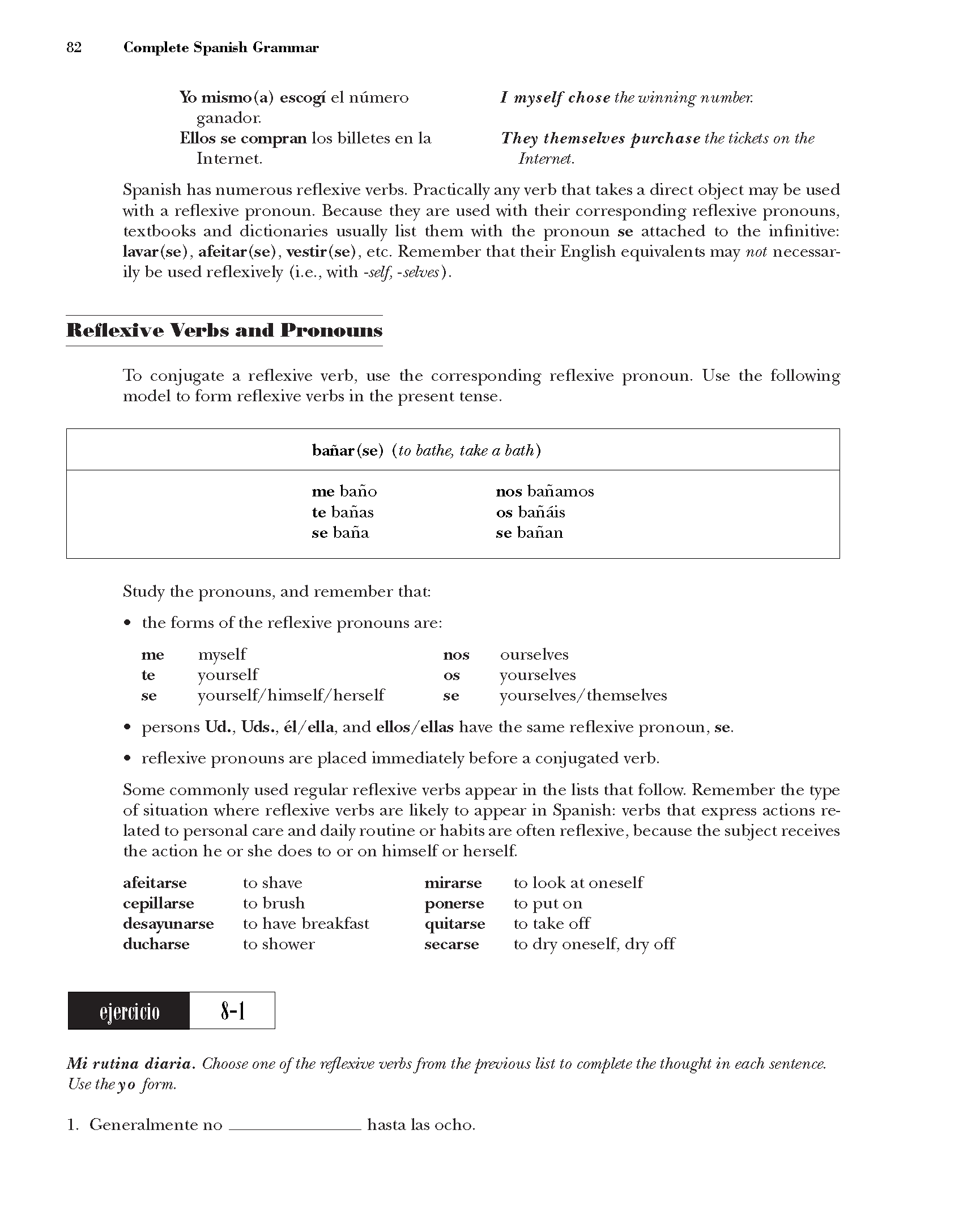CSG093

82
Complete Spanish Grammar
Yo mismo(a) escogi el nu mero I my s elf chose the winning number.
ganador.
Ellos se compran los billetes en la They themselves purchase the tickets on the
Internet. Internet.
Spanish has numerous reflexive verbs. Practically any verb that takes a direct object may be used with a reflexive pronoun. Because they are used with their corresponding reflexive pronouns, textbooks and dictionaries usually list them with the pronoun se attached to the infinitive: lavar(se), afeitar(se), vestir(se), etc. Remember that their English equivalents may not necessar-ily be used reflexively (i.e., with -self -sefaes).
Reflexive Vepbs and Pronouns
To conjugate a reflexive verb, use the corresponding reflexive pronoun. Use the following model to form reflexive verbs in the present tense.
|
banar(se) (to bathe, take |
a bath) |
|
me bano |
nos banamos |
|
te bańas |
os ban ais |
|
se bana |
se banan |
Study the pronouns, and remember that:
• the forms of the reflexive pronouns are:
me myself nos ourselves
te yourself os yourselves
se yourself/himself/herself se yourselves/ themselves
• persons Ud., Uds., el/ella, and ellos/ellas have the same reflexive pronoun, se.
• reflexive pronouns are placed immediately before a conjugated verb.
Some commonly used regular reflexive verbs appear in the lists that follow. Remember the type of situation where reflexive verbs are likely to appear in Spanish: verbs that express actions re-lated to personal care and daily routine or habits are often reflexive, because the subject receives the action he or she does to or on himself or herself.
|
afeitarse |
to shave |
mirarse |
to look at oneself |
|
cepillarse |
to brush |
ponerse |
to put on |
|
desaymiarse |
to have breakfast |
quitarse |
to take off |
|
ducharse |
to shower |
secarse |
to dr)? oneself, dr)? off |
8-1
ejercicio
Mi rutina diaria. Choose one of the reflexive verbs from the preuious list to complete the thought in each sentence. Use they o form.
1. Generalmente no_hasta las ocho.
Wyszukiwarka
Podobne podstrony:
CSG185 174 Complete Spanish Grammar 3. Yo comprarfa un equipo de sonido nuevo si (
CSG185 174 Complete Spanish Grammar 3. Yo comprarfa un equipo de sonido nuevo si (
CSG113 102 Complete Spanish Grammarejercicio En espańol. Usa el verbo entreparentesis para traducire
CSG211 200 Complete Spanish Grammar 17-10ejercicio Escribe el plural. Incluye la forma los o las del
CSG227 216 Complete Spanish Grammar Here is another group of adjectives that usually precede the nou
CSG105 94 Complete Spanish Grammar 8. Nadia y yo (nos hacemos
CSG187 176 Complete Spanish Grammar Guarden los libros ya. Pu t the books away imm
więcej podobnych podstron